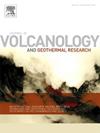Geothermal resources of Réunion Island, Indian Ocean, studied by noble gas systematics in thermal springs
IF 2.4
3区 地球科学
Q2 GEOSCIENCES, MULTIDISCIPLINARY
Journal of Volcanology and Geothermal Research
Pub Date : 2024-12-19
DOI:10.1016/j.jvolgeores.2024.108260
引用次数: 0
Abstract
La Réunion Island, home to the volcanoes Piton des Neiges and Piton de la Fournaise, hosts active hydrothermal systems fueled by a long-standing mantle plume. Understanding these systems is crucial for predicting their future potential as a geothermal resource. In this work, noble gases (Helium (He), Neon (Ne), Argon (Ar), Krypton (Kr), and Xenon (Xe)) were analyzed in 16 thermal springs to gain insights into fluid and heat sources as well as their pathways. Their helium isotopic composition or 3He/4He ratio is 13.9 ± 0.4 times higher than the atmospheric ratio (1.384 × 10−6). This ratio is comparable to those found in cumulates and xenoliths, associated with the Réunion mantle plume. Some samples show lower 3He/4He values than the plume source, indicating the addition of locally produced radiogenic 4He, likely from syenitic and basaltic products of Piton des Neiges and Piton de la Fournaise. The elemental (84Kr/36Ar and 132Xe/36Ar) and radiogenic noble gas ratios (4He/40Ar*) appear to be influenced by magma degassing and, to a lesser extent, by boiling and recondensation of fluids in the shallower part of the hydrothermal circuit. This is supported by the heat/helium (Q/3He) ratio which indicates that mantle degassing mainly controls the transfer of heat and helium through convection at the interface between the magmatic source and the geothermal system. The distribution of helium isotopic composition of fluids suggests that the heat sources feeding the geothermal system reach maximum values in two zones: the cirque of Cilaos (a circular depression south of Piton des Neiges) along an N30° rift zone and the east of Réunion Island along the N120° rift zone between the two volcanoes. These zones are the most promising targets for future geothermal exploration.
利用温泉稀有气系统研究印度洋rsamununion岛地热资源
La r union岛是Piton des Neiges火山和Piton de La Fournaise火山的所在地,拥有活跃的热液系统,由长期存在的地幔柱提供燃料。了解这些系统对于预测它们未来作为地热资源的潜力至关重要。在这项工作中,稀有气体(氦(He),氖(Ne),氩(Ar),氪(Kr)和氙(Xe))在16个温泉中进行了分析,以深入了解流体和热源及其途径。它们的氦同位素组成(3He/4He比)是大气的13.9±0.4倍(1.384 × 10−6)。这一比值与在与rsamuunion地幔柱相关的堆积物和捕虏体中发现的比值相当。一些样品的3He/4He值低于羽流源,表明添加了当地产生的放射性成因的4He,可能来自Piton des Neiges和Piton de la Fournaise的正长岩和玄武岩产物。元素(84Kr/36Ar和132Xe/36Ar)和放射性稀有气体比率(4He/40Ar*)似乎受到岩浆脱气的影响,并且在较小程度上受到热液回路较浅部分流体沸腾和再冷凝的影响。热氦比(Q/3He)支持了这一观点,表明地幔脱气主要控制热氦在岩浆源与地热系统界面的对流传递。流体氦同位素组成的分布表明,供给地热系统的热源在两个区域达到最大值:沿N30°裂谷带的Cilaos环状凹陷(Piton des Neiges以南的环状凹陷)和沿两个火山之间N120°裂谷带的r union岛东部。这些地区是未来地热勘探最有希望的目标。
本文章由计算机程序翻译,如有差异,请以英文原文为准。
求助全文
约1分钟内获得全文
求助全文
来源期刊
CiteScore
5.90
自引率
13.80%
发文量
183
审稿时长
19.7 weeks
期刊介绍:
An international research journal with focus on volcanic and geothermal processes and their impact on the environment and society.
Submission of papers covering the following aspects of volcanology and geothermal research are encouraged:
(1) Geological aspects of volcanic systems: volcano stratigraphy, structure and tectonic influence; eruptive history; evolution of volcanic landforms; eruption style and progress; dispersal patterns of lava and ash; analysis of real-time eruption observations.
(2) Geochemical and petrological aspects of volcanic rocks: magma genesis and evolution; crystallization; volatile compositions, solubility, and degassing; volcanic petrography and textural analysis.
(3) Hydrology, geochemistry and measurement of volcanic and hydrothermal fluids: volcanic gas emissions; fumaroles and springs; crater lakes; hydrothermal mineralization.
(4) Geophysical aspects of volcanic systems: physical properties of volcanic rocks and magmas; heat flow studies; volcano seismology, geodesy and remote sensing.
(5) Computational modeling and experimental simulation of magmatic and hydrothermal processes: eruption dynamics; magma transport and storage; plume dynamics and ash dispersal; lava flow dynamics; hydrothermal fluid flow; thermodynamics of aqueous fluids and melts.
(6) Volcano hazard and risk research: hazard zonation methodology, development of forecasting tools; assessment techniques for vulnerability and impact.

 求助内容:
求助内容: 应助结果提醒方式:
应助结果提醒方式:


